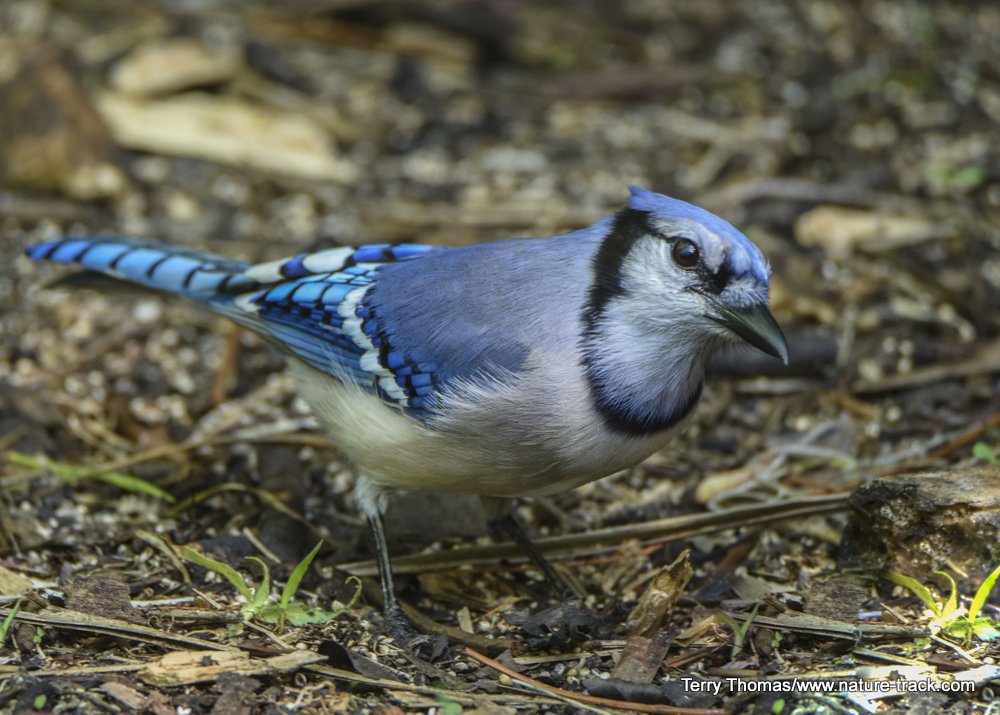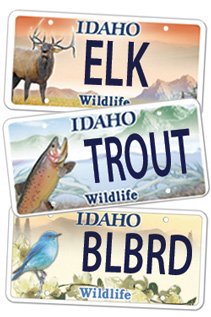Birds out of Place

A blue jay is commonly thought of as a bird of the eastern half of the continent. However, more and more are being seen in Idaho and it may be just a matter of time before we claim them as Idaho residents.
For the past several months, an Idaho birding site has had multiple entries from enthusiastic birders who have been seeing blue jays. From Island Park to Blackfoot, blue jay sighting reports keep coming in. Why is that unusual? Mainly because blue jays are regarded as an eastern species, they are year-round inhabitants only in states east of the Mississippi. They have been seen in the fringes of Idaho, including North Idaho, for years, but not as breeding pairs. In eastern Idaho, breeding or non-breeding, they are a rare treat.
There have been other rare sightings over the years in eastern Idaho. A quick check of the website, https://idfg.idaho.gov/species/observations, revealed that in Idaho, snowy owls, denizens of the Arctic, have been observed in 15 Idaho counties including Bonneville, Madison, Jefferson and Butte counties. They are quite uncommon visitors in eastern Idaho, but there are a total of 125 reported observations statewide since 1979.
The northern hawk-owl, another far north species, is an additional example. There have been 23 reported sightings in Idaho of this species since 1974. This is indeed a rare bird to see, but one spent several weeks near the Menan Buttes and Cartier Slough in 2007.
And ten years ago this week, another raptor, this time a crested caracara, was observed in Butte County. We saw this bird in Southern Arizona at the northern tip of its range and counted ourselves crazy lucky. Butte County is a long way from Southern Arizona.
Birds found far from their expected breeding, wintering and migration ranges are called vagrants or accidental birds. Sometimes these birds are thousands of miles from “home” and can stir up the birding community like a dervish.
There are a lot of potential reasons why birds are found far from traditional ranges.
Irruptions—In 2012, snowy owls seemed to be everywhere during the winter. An abundance of lemmings the previous summer had led to bonus broods and most of these young birds ended up in every province in Canada and in 31 of the 50 U.S. states, including Hawaii. Irruptions are unpredictable and don’t follow a pattern like migration. Irruptions are often thought to be caused by lack of food and occur in many species of birds when the birds move enmasse to visit new territories.
Range Expansion—Blue jays have been a tiny part of the western scene for years, but records indicate that increasing numbers of birds are wintering over. Some researchers believe that urbanization and bird feeding is encouraging this range expansion.
Wanderers—The crested caracara seen in Butte County in December 2009 was far north of its normal range and likely encountered weather that it doesn’t normally face. Why was it there? Some scientists believe that some individual birds are just more prone to travel in unexpected directions. It is, as they say, a personal thing.
Inexperience—The northern hawk-owls that visit Idaho do so in a sporadic manner suggesting that these may be young birds with no experience in migration. They may overshoot their destination, perhaps helped out by a storm or strong wind, and find themselves in Idaho or beyond. If it were to happen for several years in a row for the same bird, a genetic abnormality that affects the bird’s internal compass might be blamed. For them, the compass needle doesn’t point north (something that happens to me routinely).
Whatever the cause, if you hear about a bird that normally isn’t seen in our area, take the opportunity to try and find it. It might turn out to be a once-in-a-lifetime opportunity.
Help Idaho Wildlife
When we traveled across the state in October 2017, we visited most of the Idaho Department of Fish and Game wildlife management areas. Most of the vehicles we saw using the wildlife management areas did not have wildlife plates. Buying wildlife plates is a great way for non-hunters and hunters alike to support wildlife-based recreation like birding.
C'mon folks, let's help Idaho's wildlife by proudly buying and displaying a wildlife license plate on each of our vehicles!
See below for information on Idaho plates. Most states have wildlife plates so if you live outside Idaho, check with your state's wildlife department or vehicle licensing division for availability of state wildlife plates where you live.
And tell them that you heard about it from Nature-track.com!

Wildlife License Plates
Great news! as of 2024, there are three NEW designs for license plates. They still are bluebird, cutthroat trout and elk, but they are beautiful.
Idaho Wildlife license plates provide essential funding that benefits the great diversity of native plants and wildlife that are not hunted, fished or trapped—over 10,000 species or 98% of Idaho’s species diversity. Game species that share the same habitats (such as elk, deer, antelope, sage-grouse, salmon, trout) also benefit from these specialty plates.
No state tax dollars are provided for wildlife diversity, conservation education and recreation programs. Neither are any revenues from the sale of hunting or fishing licenses spent on nongame species. Instead, these species depend on direct donations, federal grants, fundraising initiatives—and the Idaho Wildlife license plates.
Both my vehicles have Bluebird Plates. I prefer the bluebird because the nongame program gets 70 percent of the money from bluebird plates, but only 60 percent of the money from elk and trout plates - 10 percent of the money from elk plates supports wildlife disease monitoring and testing programs (to benefit the livestock industry) and 10 percent from cutthroat plates supports non-motorized boat access.
Incidentally, in 2014, the Idaho Legislature denied the Department of Fish and Game the ability to add new plates or even to change the name of the elk and cutthroat plates (very specific) to wildlife and fish plates, a move that would have allowed for changing images occasionally and generating more revenue. It would seem that they believe that we Idahoans don't want a well funded wildlife program.
I think it is time we let the Legislature know that Idahoan support wildlife funding and that we would like to see these generic plates come to fruition.

"WOW. What a phenomenal piece you wrote. You are amazing." Jennifer Jackson
That is embarrassing, but actually a fairly typical response to my nature essays. Since The Best of Nature is created from the very best of 16 years of these nature essays published weekly in the Idaho Falls Post Register (online readership 70,000), it is a fine read. It covers a wide variety of topics including humorous glimpses of nature, philosophy, natural history, and conservation. Readers praise the style, breadth of subject matter and my ability to communicate complex and emotional topics in a relaxed and understandable manner.
Everyone can find something to love in this book. From teenagers to octogenarians, from the coffee shop to the school room, these nature essays are widely read and enjoyed.
Some of the essays here are my personal favorites, others seemed to strike a chord with readers. Most have an important message or lesson that will resonate with you. They are written with a goal to simultaneously entertain and educate about the wonderful workings of nature. Some will make you laugh out loud and others will bring a tear to the eye and warm your heart.
Readers Write:
"You hit a home run with your article on, Big Questions in Nature. It should be required reading for everyone who has lost touch with nature...great job!" Joe Chapman
"We enjoyed your column, Bloom Where Planted. Some of the best writing yet. The Post Register is fortunate to have your weekly columns." Lou Griffin.
To read more and to order a copy, click here or get the Kindle version
Copies are also available at:
Post Register
Island Park Builders Supply (upstairs)
Barnes and Noble in Idaho Falls
Harriman State Park, Island Park
Museum of Idaho
Valley Books, Jackson Wyoming
Avocet Corner Bookstore, Bear River National Wildlife Refuge, Brigham City, Utah
Craters of the Moon National Monument Bookstore, Arco, Idaho
Wildlife License Plates
Great news! as of 2024, there are three NEW designs for license plates. They still are bluebird, cutthroat trout and elk, but they are beautiful.
Idaho Wildlife license plates provide essential funding that benefits the great diversity of native plants and wildlife that are not hunted, fished or trapped—over 10,000 species or 98% of Idaho’s species diversity. Game species that share the same habitats (such as elk, deer, antelope, sage-grouse, salmon, trout) also benefit from these specialty plates.
No state tax dollars are provided for wildlife diversity, conservation education and recreation programs. Neither are any revenues from the sale of hunting or fishing licenses spent on nongame species. Instead, these species depend on direct donations, federal grants, fundraising initiatives—and the Idaho Wildlife license plates.
Both my vehicles have Bluebird Plates. I prefer the bluebird because the nongame program gets 70 percent of the money from bluebird plates, but only 60 percent of the money from elk and trout plates - 10 percent of the money from elk plates supports wildlife disease monitoring and testing programs (to benefit the livestock industry) and 10 percent from cutthroat plates supports non-motorized boat access.
Incidentally, in 2014, the Idaho Legislature denied the Department of Fish and Game the ability to add new plates or even to change the name of the elk and cutthroat plates (very specific) to wildlife and fish plates, a move that would have allowed for changing images occasionally and generating more revenue. It would seem that they believe that we Idahoans don't want a well funded wildlife program.
I think it is time we let the Legislature know that Idahoan support wildlife funding and that we would like to see these generic plates come to fruition.